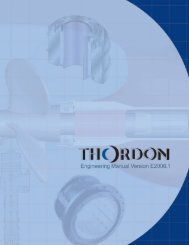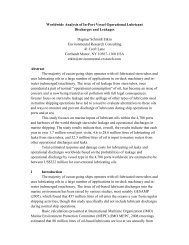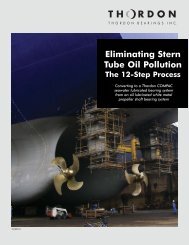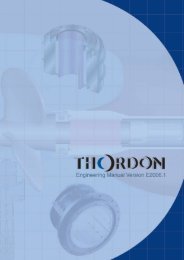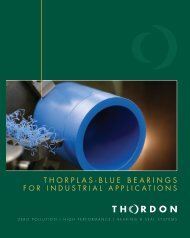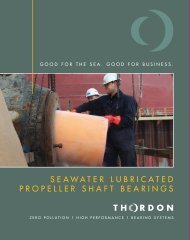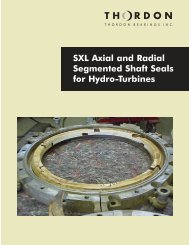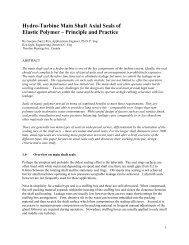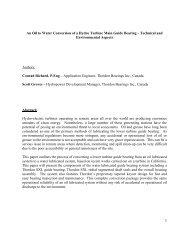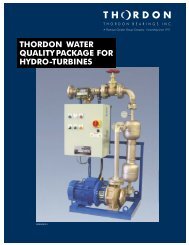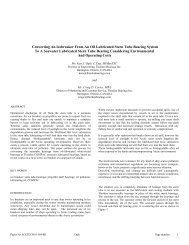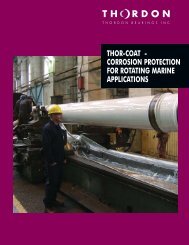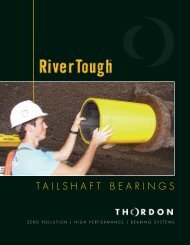Oil Lubricated Stern Tube Discharges - Thordon Bearings
Oil Lubricated Stern Tube Discharges - Thordon Bearings
Oil Lubricated Stern Tube Discharges - Thordon Bearings
Create successful ePaper yourself
Turn your PDF publications into a flip-book with our unique Google optimized e-Paper software.
WHAT IS STERN TUBE LUBRICATING OIL AND WHY IS IT AN ISSUE?<br />
Currently, the majority of commercial ocean-going ships operate with a propulsion system using a propeller<br />
shaft typically supported by oil lubricated white metal bearings with the oil contained in the stern tube by shaft<br />
seals. This “sealed stern tube system” is filled with mineral oil and sealed typically with a forward and aft lip<br />
type seal at each end as shown in Figure 1. Typical stern tubes contain 1500L (396 US gal) of mineral oil. The<br />
white metal stern tube bearings in a sealed oil system, provide for predictable and controlled wear life of the<br />
shaft bearings. This system has been in use since the 1950’s when it replaced seawater lubricated wood<br />
(lignum vitae) bearings where wooden bearing wear life was unpredictable and corrosion prevention was an<br />
issue.<br />
Figure 1. A typical oil lubricated stern tube bearing system<br />
However, there are some issues with an oil lubricated stern tube bearing system and the issues have become<br />
much more prevalent today with concerns over any ship source pollution.<br />
Operational Discharge<br />
The two shaft seals containing the oil require frequent maintenance or oil will leak into the sea or into the<br />
ship. <strong>Stern</strong> tube seal oil leakage from a ship is considered “normal operational consumption” and typically<br />
an acceptable practice. According to seal manufacturers, the seal must leak (aft-into the sea or forward-into<br />
the ships bilge) at the shaft/seal interface in order for the seal to function properly.<br />
Wartsila Propulsion (<strong>Bearings</strong> & Seals), UK<br />
“<strong>Oil</strong> consumption from the seal is controlled to the minimum acceptable to maintain an acceptable life,<br />
but by design it is essential to have oil at the mating surfaces.”<br />
“<strong>Oil</strong> consumption is always lost direct to the sea so contaminating the environment.”<br />
“The best estimates that can be made can only be based on seals in a lab condition running in clean<br />
and controlled environments but even this indicates an excess of 10,000,000 liters/year of oil is lost.<br />
Many organizations predict far higher in reality but difficult to prove with facts.”<br />
Higgenbottom, Adrian. Wartsila Propulsion (<strong>Bearings</strong> & Seals) UK, “Coastguard Non-Polluting <strong>Stern</strong> tube Sealing System,” presented<br />
at the RINA International Conference for the Design and Operation of Container Ships, 23-24 April 2003, London, UK , pp 53-60.<br />
KEMEL, Japan<br />
“In stern tube bearings, the radial movement of the shaft is considerably larger than that of bearings for<br />
general industrial application. In addition, external disturbances such as rough seas and vibration are<br />
considerable. It is practically impossible to seal the stern tube oil perfectly. Therefore, one of the serious<br />
environmental issues in medium and large commercial vessels is stern tube oil leakage.”<br />
Sada, Hiroyuki, Seiji Yamajo, David W. Hawkins and Tsuyoshi Kawazoe. Kobelco Eagle Marine Engineering Co. Ltd., Japan, “An<br />
Environmentally Compatible Lubricant for <strong>Stern</strong> <strong>Tube</strong> Shafting and Bearing Systems,” presented at the 11th Shafting Symposium of the<br />
Society of Naval Architects and Marine Engineers, Sept. 12-12 2006, Williamsburg, VA, U.S.A., pp 1.<br />
1



